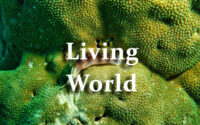Ecosystem
1. Which ecosystem has the maximum biomass?
A. Forest ecosystem
B. Grassland ecosystem
C. Pond ecosystem
D. Lake ecosystem
2. The primary producers of the deep-sea hydrothermal vent ecosystem are—
A. green algae
B. chemosynthetic bacteria
C. blue-green algae
D. coral reefs
3. The term ecosystem was coined by—
A. E. Haeckel
B. E. Warming
C. E. P. Odum
D. A. G. Tansley
4. Which one of the following is a characteristic feature of cropland ecosystem?
A. Absence of weeds
B. Ecological succession
C. Absence of soil organisms
D. Least genetic diversity
5. Identify the ecologist from the given hints.
A. He carried out long-term ecosystem experiments using outdoor plots.
B. In his experiments he showed that “increased diversity contributed to higher productivity”.
A. Ahemed Khan
B. David Tilman
C. Stanley Cohen
D. Ernest Chain
6. The gross primary productivity of an ecosystem is 170 tons of organic matter and amount used in respiration is 50 tons. Calculate the net primary productivity of the ecosystem.
A. 120 tons
B. 100 tons
C. 70 tons
D. 12 tons
7. The pioneer species in xerarch and hydrarch succession are respectively
A. lichens and sedges
B. phytoplanktons and sedges
C. lichens and zooplanktons
D. lichens and phytoplanktons
8. The rate of formation of new organic matter by deer in a forest ecosystem is called—
A. standing crop
B. primary productivity
C. net primary productivity
D. secondary productivity
9. Most animals that live in deep oceanic waters are :
A. tertiary consumers
B. detrivores
C. primary consumers
D. secondary consumers
10. The overlapping zone in between two ecosystems is known as
A. Ecozone
B. Biotope
C. Ecotone
D. buffer zone
11. The animal species controlling the ecosystem functioning is known as—
A. edge species
B. pioneer species
C. keystone species
D. umbrella species
12. Which of the following statements is incorrect?
A. Oceans contain about 71% of total global carbon.
B. Atmosphere contain about 71% of total global carbon.
C. Carbon constitute about 49% of the dry weight of organisms.
D. Approximately 4 X 1013 kg of carbon is fixed in the biosphere through photosynthesis annually.
13. The rate of biomass production and the rate of production of organic matter during photosynthesis are called respectively-
A. total productivity, primary production
B. gross primary productivity, gross secondary productivity
C. net primary productivity, gross secondary productivity
D. productivity, gross primary productivity.
14. Select the correct statement-
A. Phosphorus cycle is an example of gaseous nutrient cycle.
B. The pyramid of biomass in sea is generally inverted.
C. By the process of humification, soluble inorganic nutrients go down into the soil horizon.
D. A given organism may not occupy more than one trophic level simultaneously.
15. The first trophic level in an ecosystem consists of—
A. primary producers
B. primary consumers
C. secondary producers
D. secondary consumers
E. top carnivores
16. The breakdown of detritus into small particles by detritivores is called-
A. Leaching
B. Humification
C. fragmentation
D. catabolism
17. If 301 of energy is trapped at producer level, then how much energy will be available to peacock as food in the following chain?
Plant —> Mice —> Snake —> Peacock
A. 0.3J
B. 0.03J
C. 0.0003J
D. 0.003J
18. Plant species having a wide range of genetical distribution evolve into a local population known as—
A. Ecotype
B. Biome
C. Ecosystem
D. population
19. Energy flow in ecosystem is—
A. Bidirectional
B. Multidirectlonal
C. unidirectional
D. all around
20. In a lake, phytoplankton grow in abundance in—
A. littoral zone
B. limnetic zone
C. profundal zone
D. benthic region
21. If the energy produced at the level of the producers is 10001, the energy available for the secondary consumers—
A. 1000J
B. 100J
C. 10J
D. 1J
22. For the sedimentary type of biogeochemical cycle the reservoir is—
A. Atmosphere
B. water
C. earth’s crust
D. living organisms
23. Which of the following serves as a reservoir of phosphorus in phosphorus cycle?
A. Soil
B. Rocks
C. Living matter
D. Atmosphere
24. If 20J of energy is trapped at producer level, then how much energy will be available to peacock as food in the following chain?
Plant —> Mice —> Snake -—> Peacock
A. 0.02J
B. 0.002J
C. 0.2J
D. 0.0002J
25. Which of the following process will be most adversely affected if microorganisms are removed from a forest ecosystem?
A. solar energy fixation and nutrient cycling
B. Decomposition of organic matter and photosynthesis
C. Nitrogen fixation and decomposition of organic matter
D. Carbon assimilation and nitrogen fixation
26. Which of the following statements (s) regarding energy flow is/are false?
I. The detritus food chain being with dead organic matter.
II. In aquatic ecosystem, detritus food chain is the major conduit for energy flow.
III. in terrestrial ecosystem a larger fraction of energy flows through gazing food chain.
IV. Producers belong to the first trophic level of the food chain
A. II and III
B. only II and IV only
C. I and IV only
D. l and II only
27. Which of the following statements about productivity is true?
A. Primary productivity of all ecosystems is a constant.
B. The annual net primary productivity of the whole of the biosphere is 17 billion tons (dry weight) of organic matter.
C. Net primary productivity is the amount of biomass available for consumption by carnivores.
D. Primary productivity depends on the plant species inhabiting a particular area.
28. Identify the incorrect statement from the following.
A. Atmospheric inputs of phosphorous through rainfall are much smaller than carbon inputs.
B. The reservoir pool for phosphorous cycle is earth’s crust whereas atmosphere is the reservoir pool for carbon cycle.
C. Gaseous exchanges of phosphorous between organism and environment are negligible.
D. During carbon cycle and phosphorous cycle, there is very little respiratory release of carbon and phosphorous respectively.
29. Identify the incorrect statement from the following-
A. Pyramid of biomass in sea is generally inverted as the biomass of fish far exceeds that of phytoplanktons.
B. Pyramid of energy is mostly upright, but sometimes it may be inverted.
C. Food chains are generally short with few trophic levels as only 10% of the energy is transferred to each trophic level from the lower trophic level.
D. Pyramids of number and biomass may be either upright or inverted.
30. Lindeman for the first time gave energy transfer law, which states that—
A. only 20% of the energy is transferred to each trophic level
B. only 10% of the energy is transferred to each trophic level
C. only 30% of the energy is transferred to each trophic level
D. only 50% of the energy is transferred to each trophic level.
31. Gross primary productivity is the rate of production of ___________ during photosynthesis.
A. organic matter
B. oxygen
C. carbon dioxide
D. chlorophyll
32. Which of the following statements about the food chain is false-
A. Detritus food chain begins with dead organic matter
B. Carnivores are secondary consumers
C. Primary consumers are herbivores
D. Earthworm in detritus food chain is a primary producer.
33. Which of the following statements is incorrect—
A. The species that invade a bare area are called pioneer species
B. The entire sequence of communities that successively change in a given area are called sere
C. Pyramid of energy is always inverted
D. Pyramid of numbers in a tree ecosystem can be inverted.
34. Which helps in maintaining species diversity in a community-
A. Omnivores
B. Predators
C. Herbivores
D. Facultative parasites.
35. Natural reservoir of phosphorus is
A. Rock
B. Fossils
C. sea water
D. animal bones
36. Secondary productivity is rate of formation of new organic matter by—
A. Consumers
B. Decomposers
C. Producers
D. parasites
37. Which one of the following processes during decomposition is correctly described?
A. Catabolism—Last step in the decomposition under fully anaerobic condition
B. Leaching—Water soluble inorganic nutrients rise to the top layers of soil
C. Fragmentation—Carried out by organisms such as earthworm
D. Humification—Leads to the accumulation of a dark coloured substance humus which undergoes microbial action at a very fast rate.
38. Biological equilibrium is found among the—
A. producers and light
B. producers and consumers
C. producers and decomposers
D. producers, consumers and decomposers
39. The upright pyramid of number is absent in—
A. pond
B. forest
C. lake
D. grassland
40. The correct sequence of seral stages in hydrosere is—
A. plankton, submerged, floating, reed swamp, sedge meadow, woodland
B. plankton, floating, submerged, reed swamp, sedge meadow, woodland
C. plankton, submerged, floating, sedge meadow, reed swamp, woodland
D. plankton, submerged, floating, sedge meadow, woodland, reed swamp.
41. In a pyramid of biomass, if the total dry weight (kg/m2) of primary producers is about 809 it will decrease at tertiary consumer level upto—
A. 37 kg/m2
B. 11 kg/m2
C. 5 kg/ m2
D. 1.5 kg/m2
42. Full name of professor Misra who is known as the Father of Ecology in India is—
A. Ramesh Misra
B. Ramavatar Misra
C. Ramakant Misra
D. Ramdeo Misra
43. An inverted pyramid of number and an inverted pyramid of biomass are respectively seen in—
A. grassland and tree ecosystem
B. sea and tree ecosystem
C. tree and sea ecosystem
D. sea and grassland ecosystem
44. When man eats fish which feeds on zooplankton which have eaten small plants, the producer in this chain is—
A. small plants
B. fish
C. man
D. zooplankton
45. Which of the following is a primary consumer in maize field ecosystem?
A. Grasshopper
B. Wolf
C. Phytoplankton
D. Lion
46. Which two distinct microbial processes are responsible for the release of fixed nitrogen as dinitrogen gas (N2) to the atmosphere?
A. Aerobic nitrate oxidation and nitrite reduction
B. Decomposition of organic nitrogen and conversion of dinitrogen to ammonium compounds
C. Enteric fermentation in cattle and nitrogen fixation by Rhizobium in root nodules of legumes
D. Anaerobic ammonium oxidation and denitrification
47. The second stage of hydrosere is occupied by plants like—
A. Azolla
B. Typha
C. Salix
D. Vallisneria
48. The rate of formation of new organic matter by rabbit in a grassland, is called-
A. net productivity
B. secondary productivity
C. net primary productivity
D. gross primary productivity
49. Which one of the following is not a functional unit of an ecosystem?
A. Energy flow
B. Decomposition
C. Productivity
D. Stratification
50. Identify the possible link “A” in the following food chain.-
Plant —> Insect -> Frog —>”A” —> Eagle
A. Rabbit
B. Wolf
C. Cobra
D. Parrot
51. Which one of the following is not a gaseous biogeochemical cycle in ecosystem?
A. Sulphur cycle
B. Phosphorus cycle
C. Nitrogen cycle
D. Carbon cycle
52. For clean environment, which one of the following is not essential?
A. Producer
B. Consumer
C. Decomposer
D. Polluter
53. The range of biomagnification of DDT is an SQ aquatic food chain, if starting from 0.003 ppm level in water may go at fish-eating bird level upto—
A. 0.5 ppm
B. 5.0 ppm
C. 15.0 ppm
D. 25.0 ppm
54. In an ecosystem, at a particular time, standing crop includes—
A. total living material
B. total detritus
C. both (a) and (b)
D. total nutrients present in the crop



